Experimental Design 2
1/29
There's no tags or description
Looks like no tags are added yet.
Name | Mastery | Learn | Test | Matching | Spaced |
|---|
No study sessions yet.
30 Terms
define experimental design
the process of carrying out research in an objective and controlled fashion so precision is maximised and specific conclusions can be drawn about a pre-existing hypothesis
good design = valid conclusion
research cycle
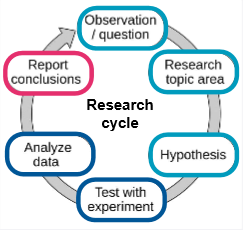
what is the aim of a ‘true experiment’?
to establish the effect of an IV on an outcome measure, with only one difference between groups and everything else remaining constant to minimise variation
define hypothesisb
a testable prediction, likely based on literature or a previous experiment
what makes a good hypothysis?
states what you expect to find, with a direction
be testable
contain an IV and an outcome measure (DV)
7 key choices to make in experimental design
subjects
techniques
control groups
randomisation
sample size
statistical analysis
advantages of cells as a subject
give insight into molecular mechanisms, such as mitochondrial function and genetics
disadvantages of cells as a subject
lack of peripheral influence (eg. from gut microbiome-brain axis and hypothalamic-pituitary-adrenal axis)
advantages of animals as subjects
use of whole animals to do invasive studies which can demonstrate cause and effect
disadvantages of animals as subjects
ethical considerations
differences between species, so a lack of translation to humans
vertebrates and invertebrates differ, so mammals may be required
need correct brain region, neurological chemicals or behaviours
advantages of humans as subjects
relevance to complex human emotion and disease
disadvantages of humans as subjects
regulatory constraints
recruitment difficulties
difficulty controlling all variables
factors to consider when choosing subjects
ethics
time
finances
choosing species in animal studies
the legal and ethical obligation is to use the simplest and least sentient species appropriate for the scientific objective
must have the correct brain regions, chemicals and behaviours
why are primates used to study the granular frontal cortex
rodents lack a granular frontal cortex
this is involved in higher cognitive functions (conceptualising, planning and prioritising)
these behaviours cannot be studied in rodents
this justifies the use of primates
choosing strains for rodent studies
there is no standard lab rat or mouse
different strains differ in sight, activity, sociability, stress response and cognition
therefore different strains are preferred for different types of study
choosing the age of subjects in an animal experiment
lifespan and developmental milestones differ based on species
in humans, apoptosis and myelination begin in utero whereas this starts postnatally in rodents
therefore experimental interventions and data collection need to be timed appropriately to be relevant
effects of supplier and in-house conditions when selecting rodents for a study
rodents can be kept differently, husbandry differs by institution
this can affect the outcome
more enriched cages can encourage more neurogenesis
this can cause different baseline conditions
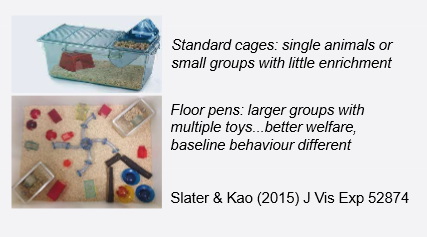
choosing the sex of animal subjects
females are no longer viewed as more variable
both make and female are starting to be used unless there is a specific reason not to
mouse handling methods
must be used to handling before the experiment
picking up by the tail causes anxiety and aversion so the mouse will not engage
reduces willingness to explore in behavioural testing
impacts data
Picking up by tunnel or cup is preferred as allows habituation
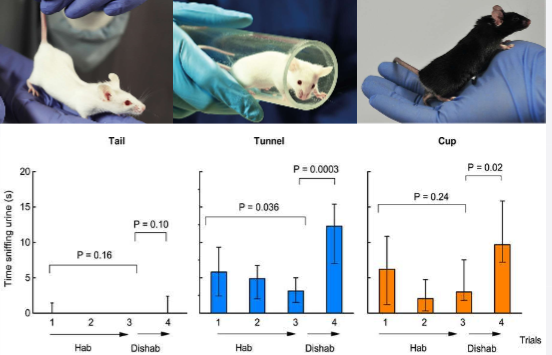
role of studies using normal animals
illustrate physiological roles of neurotransmitters
cannot predict efficacy
role of studies using disease models
use genetic, environmental or surgical manipulation to mirror known risks and symptoms
provide better predictions of clinical efficacy
choosing behavioural tests
there are multiple tests for different things like pain, cognition etc
the cognitive domain and disease being tested changes the relevant testing technique
some domains cannot be tested in animals
different cognitive tests fit different diseases better
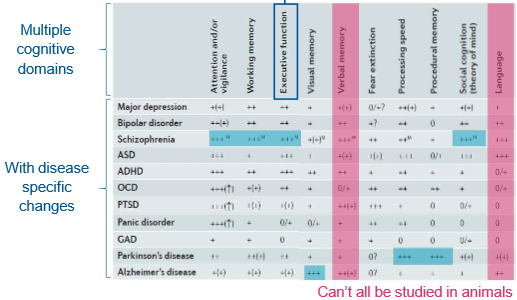
Wisconsin card sorting test
for humans
test executive function
cards are sorted by a category, which changes
time for new rule to be realised
relevant in schizophrenia, ASD and ADHD
less relevant in PTSD and AD
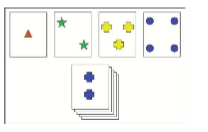
Attentional set shifting task test
used in rodents
tests executive function
rule for what food us under (material and smell) is changed
time for new rule to be realised
relevant in schizophrenia, ASD and ADHD
less relevant in PTSD and AD
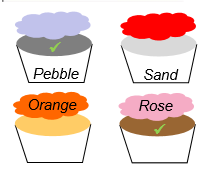
Control group
everything is the same as it is for the experimental group, but the IV is not manipulated
why are positive and negative controls necessary?
show that the assay correctly detects the outcome measure correctly
do not actually address the hypothesis
Positive control
shows that the experiment could detect a positive effect if it was to occur
is reassuring if the IV has no effect
Negative control
shows that the experiment does not give artificial positive effects
is reassuring if the IV increases readout